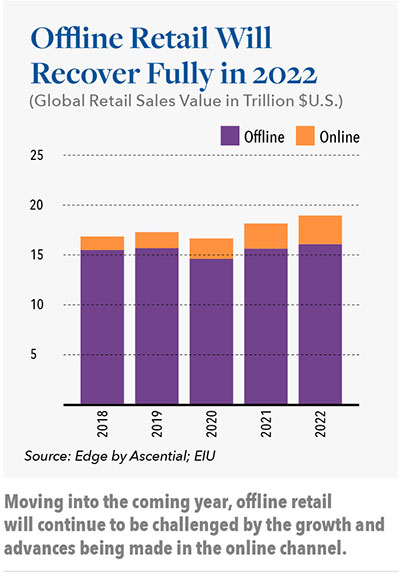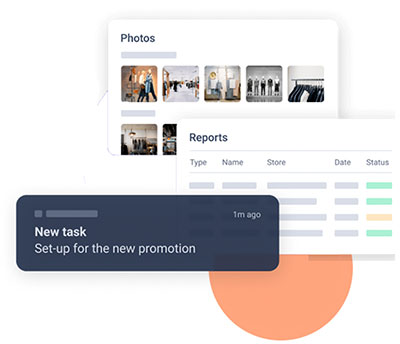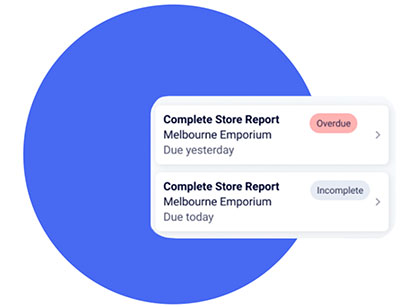How Technology Can Help Drive Best Practices and Successful Selling Strategies in the Retail Environment

The new athleisure wear collection flew off the shelves at one location but underperformed at most all of the retailer’s other sites. Why? Decoding retail success, especially given the chaotic economic environment of the past few years, is a complex undertaking. This article examines how the retail industry can benefit by embracing new, available technologies, deploy innovative business intelligence tools, and train employees to drive successful outcomes during this transitional period in retail’s evolution.
This year is throwing a plethora of curveballs at the retail industry. While that’s not entirely different than what we observed in 2020 or 2021, these potential obstacles seem to just keep on coming. The good news is that the toolkit for dealing with each new challenge — be it inflation, the labor squeeze, or COVID anxiety (or apathy) — is evolving as well. Identifying and deploying the right technologies will be one of the key differentiators for retail success during the next couple of years.
In its “Consumer Goods and Retail in 2022” report released at the end of last year, the Economist Intelligence Unit (EIU is the research group at the Economist) predicted that while retail volume growth this year would slow to 3.3% on an inflation adjusted basis, it would finally exceed the level seen prior to the pandemic in 2019. While the retail sector had been pacing well against this metric during the first half of this year, the second half of 2022 is shaping up to be potentially more volatile.

What should retailers do? It’s going to take a lot of offense and a bit of defense to weather the next several months, and perhaps even years. According to the EIU report, “While companies try to gauge their pricing strategies, they will turn to new technologies in the hope of finding long-term solutions.” From our perspective, all indicators suggest that those solutions should include automation, artificial intelligence, and new systems for better managing both front- and back-of-house operations.
One of the most difficult tasks for many retailers is deciding what to prioritize and how much to invest. The industry is facing a tipping point. While many retailers pivoted in 2020 and invested significantly to ramp up their online offerings in response to the COVID crisis, consumer preferences continue to evolve. Keeping pace is a complex, full time endeavor as illustrated by the fact that consumer shopping behavior is now starting to shift back toward brick & mortar. According to Accenture’s 2021 report: “Life Reimagined. Mapping the motivations that matter for today’s consumers,” in the post-COVID marketplace consumers’ motivations will extend well beyond price and quality.

So, how can retail operators not only adjust to, but actually capitalize on, these shifts? Without question, it is going to take a multi-pronged approach which recognizes and truly embraces the fact that omnichannel is here to stay. Where or how a customer clicks on, tries on, buys, picks up, or returns an item may well involve numerous channels across a single purchase cycle. A retail research project conducted in late 2021 by Square, entitled “The Future of Retail: 2022 Edition,” drives home the point: “Customers’ journey from browsing to buying is often nonlinear, meaning they may go back and forth on multiple channels while browsing and researching before they settle on buying.” Square partnered with Wakefield Research and surveyed 1,000 customers and 500 retail owners and managers to uncover what businesses can expect in 2022. Their research also revealed that customers want, “seamless experiences whether they are shopping in-store, online, or anywhere in between.”
So, if customers want their shopping experiences to be seamless and efficient, how can retailers best equip their employees to deliver on that expectation consistently, starting inside the retail store environment? Deployment of business intelligence tools that take a comprehensive look at all segments of the retail operation can help retailers streamline operations, sell more effectively and enhance the customer experience. To get employees on the selling floor, in the stockroom and elsewhere in the field engaged, and to leverage their true potential toward these objectives, we believe it is becoming increasingly important for retail executives and decision-makers to recognize the importance of equipping them with easy-to-use technology and actionable information that helps to continuously improve processes across the retail environment.
Are stockrooms organized and managed for optimal efficiency? Is this season’s denim collection displayed for maximum visual impact and customer ease in size selection? Are sales staff well trained on how to talk about the quality and features of collections currently on the sales floor in a way that helps move product off shelves to make room for incoming items and stockroom inventory?
Though surprising to many, in our work at ReStore for Retail, we find that in many cases the answers to the above questions are not actually known. And the recent pandemic period, with 1) more limited travel available for regional and other managers to visit store locations across their geographies and 2) many longtime, experienced sales floor and stockroom personnel out for extended periods or exiting the retail workforce, has only served to exacerbate that knowledge gap. Think about it this way, a mere 14 less boxes in the storeroom can translate to 700 more items on the floor. Bottom line? Without the right data and the ability to analyze it in an efficient and effective manner, buying, distribution, merchandising and sales decisions become increasingly more difficult, speculative and ultimately ineffective.





The right technology, when deployed properly, can help to inform decision makers across the business in a timely and near-effortless manner about how each individual store’s daily, weekly, monthly or quarterly sales figures for a given department, collection or sales event correlate to any number of factors present in that specific store environment. For example, machine learning built into an application deployed to store and department managers right on their own phones can be used to analyze store photographs, enabling management to identify which colors and sizes of sweaters, shirts, pants or jackets were displayed and in what order. Users can determine where certain collections were set in relation to others, what position and how much floor space they occupied and how well maintained those displays were during various hours of the shopping day. Sales staff interaction with customers can also be observed to determine if they are in keeping with guidelines.
In the back of the store, the same technology can be used to see which locations have stock grouped appropriately, whether the stockroom is orderly with product easily accessible, and to note weekly or other trends regarding stock shortfalls or abundance. Employee training and self-guided learning hours can be tracked and assessed in relation to individual performance levels as well. All of this information, in turn, can be pegged to the performance of any one store vs. others in the system, allowing merchandising and other best practices to be established based on data points derived from system analytics.

14 less boxes in the storeroom
can translate to 700 more items
on the floor.
Because these features can all be delivered and utilized via an app easily installed on an employee’s/ subscriber’s Android or IOS device, those on location in the workforce, become the eyes and ears of the greater organization. Store and department managers can file end of day and other reports quickly and easily on their own phones, snapping photos in store with the same level of comfort that they snap selfies and photos of friends, and seamlessly adding relevant notations. This enables them to complete their responsibilities on store premises more quickly, which contributes to a better work/life balance; something that has become increasingly important to those already working in, or seeking employment with, retail businesses since the start of COVID. Having already deployed this type of technology into numerous retail environments, our team has seen first-hand that empowering employees in this manner is leading to higher levels of engagement, commitment and job satisfaction. Feedback from retail operations and HR teams confirms that as well. Additionally, with these app equipped devices in employees’ hands 24/7, management can issue operational bulletins, conduct tailored surveys to different employee populations, and even deliver emergency/crisis instructions with confidence that they will be seen and acted on in a timely manner.
Information sharing among stores, across all channels, and up and down the organization is essential as well. Deploying tools such as these that are capable of aggregating visual and other data into timely and actionable surveys and reports, can help drive development and delivery of more impactful training information and highly relevant best practices, leading to improved results against KPIs moving forward.
The Accenture report mentioned earlier in this article also points out that, “To drive growth, companies must reimagine their entire business through the lens of customer experience which [in part] entails structuring the entire organization to create experiences that capture consumers’ evolving demands across all aspects of operations.” If the pandemic did anything, it made customers hypersensitive to their customer service interactions. There is no doubt that customers will continue to demand ever-faster response times, more attention to detail, and more acknowledgment of their individual needs and concerns. Every touch point with a customer is part of the experience, so the people and the technologies that consumers interact will need to positively reinforce and enhance the experience.

As retailers set out to meet these heightened consumer expectations, the range of relevant datapoints that can be gained through the type of technology applications described above will empower their ability to gain a greater understanding of how strategies and implementations are working and can be improved across the organization. This is of particular importance with the retail landscape and the next phase of omnichannel continuing to evolve at such a rapid pace. According to the Square report, 42% percent of retailers now say they are either already, or plan to begin, selling via text or chat, while 34% are either already, or plan to begin, automating their customer communications. Add to this, the fact that 27% of customers now also say that they are interested in making purchases directly on social media when that feature is offered by a retailer, and the importance of every touchpoint working seamlessly together becomes even more profoundly apparent. From display impact on the retail selling floor, to organization in the stockroom, online ordering, delivery and exchange friendliness and ease, operational intelligence has never been more critical to a retailer’s future success than it is at this moment in time.
CONCLUSIONS
All indicators point toward the importance of getting everyone across the retail organization to embrace the use of transparent and collaborative technology to enable timely gathering and sharing of information and ideas, support quick turnarounds on improvements, best-practices and successful selling strategies. In the current environment, the deployment of any new technology should be part of an overarching commitment to sustained improvement in retail execution across both brick and mortar and ecommerce, including warehousing, distribution and other supporting infrastructure. Its use should make employees feel good about the efforts they are making and the positive results they are impacting. Ultimately, of course, the system and its underlying technology should and must create actual, measurable performance improvement across predetermined and trackable measures.
At Hilco Merchant Resources we have a wealth of experience in the retail sector. Over many years of working with retailers, both thriving and distressed, we have helped companies address issues ranging from overhauling inventory management, to how to capitalize on the seasonality of a product line, to revamping in-store merchandising to maximize sales. We have deployed technologies to support these initiatives, and ultimately designed our own platform — ReStore for Retail — because we saw an opportunity to help retailers innovate the way they bring their stores teams and data together to create greater transparency, efficiency and improved results.
During this complex period in the retail market’s evolution, we are working with retailers on a number of fronts and continue to have enlightening conversations with our partners and contacts across the industry on a daily basis. If there is a challenge facing your retail business, or a retail business in your portfolio right now, chances are that your team(s) could benefit from our experience and the type of business intelligence discussed in this article. With that in mind, we encourage you to reach out to us for a conversation. We are here to help!



